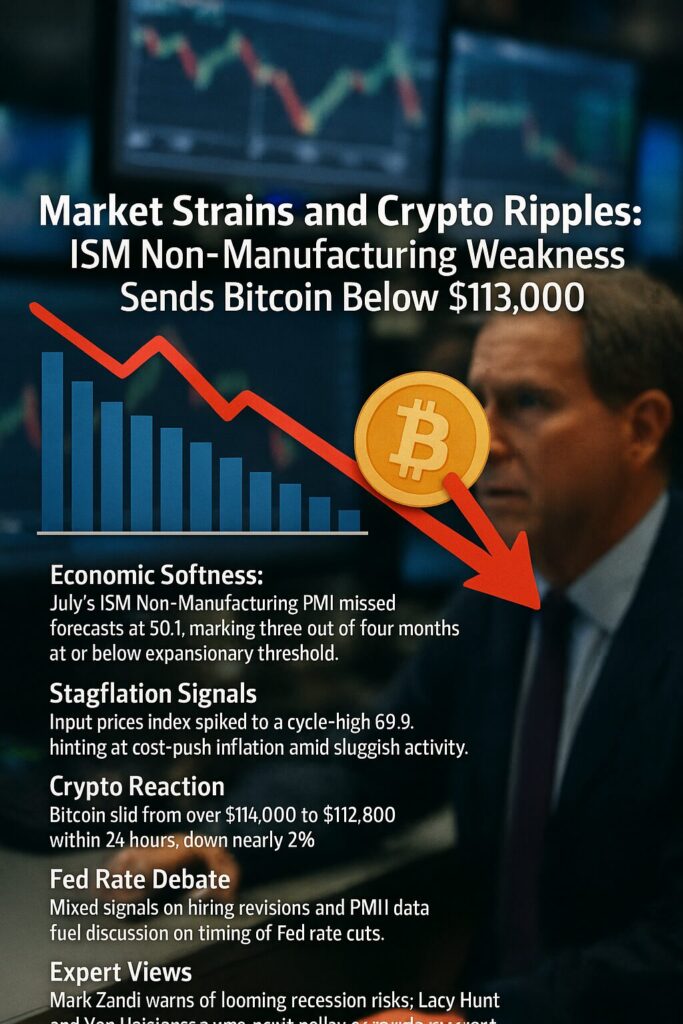
Main Points:
- Economic Softness: July’s ISM Non-Manufacturing PMI missed forecasts at 50.1, marking three out of four months at or below expansionary threshold.
- Stagflation Signals: Input prices index spiked to a cycle-high 69.9, hinting at cost-push inflation amid sluggish activity.
- Crypto Reaction: Bitcoin slid from over $114,000 to $112,800 within 24 hours, down nearly 2%.
- Fed Rate Debate: Mixed signals on hiring revisions and PMI data fuel discussion on timing of Fed rate cuts.
- Expert Views: Mark Zandi warns of looming recession risks; Lacy Hunt and Van Hoisington urge swift policy easing to preempt deeper economic contraction.
1. Economic Softness Extends into Services
July’s ISM Non-Manufacturing PMI registered 50.1, falling short of the 51.5 consensus and hovering just above the 50-point expansion/contraction divide. This follows 49.9 in May and 50.8 in June, underscoring a multi-month deceleration in services activity. The consistent underperformance suggests the economy’s non-manufacturing sector remains vulnerable despite pockets of resilience.
(Insert Figure 1 here: ISM Non-Manufacturing PMI Trend)

2. Rising Costs Signal Stagflationary Pressures
Alongside soft output figures, the ISM report highlighted a surge in the Prices Paid Index, which climbed to 69.9, the highest level in the current cycle. Businesses cited elevated input costs—particularly tariffs on equipment and supplies—as forcing postponement of other projects. This cost-push inflation amid slowing demand resembles early stagflationary patterns.
3. Bitcoin’s Reaction to Macro Headwinds
On August 5, Bitcoin’s price fell from above $114,000 to $112,800, a near 2% drop in 24 hours, as markets digested both the ISM report and revised down U.S. hiring figures announced on August 1. The decline erased recent gains on risk sentiment, aligning crypto’s volatility with equities: the Nasdaq turned negative, slipping 0.5% on the day.
(Insert Figure 2 here: Bitcoin Price Trend)

4. Fed Rate-Cut Timing Under Scrutiny
The combination of downward-revised payroll data and weak services PMI has intensified debate over when the Federal Reserve might pivot to rate cuts. Economists argue that persistent data revisions—often larger at cyclical turning points—underscore the fragility of current expansion.
5. Expert Perspectives on Policy Path
5.1 Mark Zandi on Imminent Turn
Economist Mark Zandi suggests that the economy is teetering on the brink of recession, noting flat consumer spending and contraction in construction and manufacturing. He warns that rising inflation complicates the Fed’s calculus, making an immediate rate cut politically and technically challenging.
5.2 Hunt & Hoisington Urge Swift Easing
Lacy Hunt and Van Hoisington of Hoisington Investment Management view tariff-induced inflation as transitory. They emphasize that the secondary and tertiary effects of contracting global activity pose greater risks. “The Fed should transition rapidly to easing policy,” they conclude, arguing that delaying could exacerbate the depth of the upcoming downturn.
6. Recent Trends in Crypto and Beyond
To place these developments in context:
- Stablecoin Growth: Tether and USDC supply have expanded by over 15% year-to-date, reflecting growing demand for dollar-pegged liquidity amid market uncertainty.
- Institutional Inflows: Monthly institutional crypto fund inflows reached $400 million in July, up 25% from June, suggesting some investors view dips as buying opportunities.
- On-chain Usage: Ethereum Layer-2 networks saw a 10% uptick in daily active addresses over the past week, indicating resilient on-chain activity despite price fluctuations.
- Macro Risk Hedging: Bitcoin’s correlation with real yields has increased, reinforcing its role as a tactical hedge when real rates rise and traditional assets falter.
Conclusion
July’s services PMI disappointment and rising input costs paint a mixed macroeconomic picture—soft demand coupled with stubborn inflation. Bitcoin’s recent pullback under $113,000 underscores crypto’s sensitivity to Fed policy expectations and broader market sentiment. As economists debate the timing of rate cuts, stablecoin expansion and institutional inflows point to ongoing structural growth in digital assets. For practitioners eyeing new opportunities, staying attuned to economic indicators and on-chain metrics will be critical in navigating the evolving intersection of macro policy and crypto markets.

